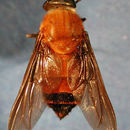Distribution
provided by INBio
Distribucion en Costa Rica:
Distribucion General: Mexico to eastern Peru and northern Brazil.
- author
- John Burger
- editor
- Manuel A. Zumbado
- editor
- Cristian Granados y Elvia Zumbado
Trophic Strategy
provided by INBio
Adults feed on nectar of flowers (males and females) and the blood of mammals (females).
- author
- John Burger
- editor
- Manuel A. Zumbado
- editor
- Cristian Granados y Elvia Zumbado
Life Cycle
provided by INBio
Immature stages unknown.
- author
- John Burger
- editor
- Manuel A. Zumbado
- editor
- Cristian Granados y Elvia Zumbado
Diagnostic Description
provided by INBio
Hind tibiae with apical spurs; antennal flagellum with 8 distinct flagellomeres; ocelli well developed; eyes bare; oculogenal margin with a distinct row of hairs below the subantennal suture; maxillary palpi usually over half the length of the proboscis; proboscis length less than head height; legs black; mesoscutum and scutellum orange tomentose and pilose; abdomen with first two segments horn colored, remainder black (female) or first 3 segments bright orange (male).
- author
- John Burger
- editor
- Manuel A. Zumbado
- editor
- Cristian Granados y Elvia Zumbado
Diagnostic Description
provided by INBio
Localidad del tipo: "Brazil"
Depositario del tipo: Holotype female lost.
Recolector del tipo:
- author
- John Burger
- editor
- Manuel A. Zumbado
- editor
- Cristian Granados y Elvia Zumbado
Conservation Status
provided by INBio
This species is not particularly common in Costa Rica.
- author
- John Burger
- editor
- Manuel A. Zumbado
- editor
- Cristian Granados y Elvia Zumbado

